 |
|
I Ching & The Human Body
Class Five: Early Heaven, Later Heaven,
& the Wheel of Vertical time
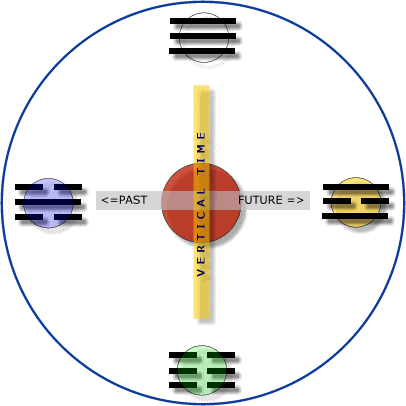
Wheel of Vertical Time.
 Class Five: Earlier Heaven, Later Heaven and Vertical Time. Please study this page with Audio Lecture Five.
Class Five: Earlier Heaven, Later Heaven and Vertical Time. Please study this page with Audio Lecture Five.
Abstract: The benefit of "practice" as invoking our highest priority; of orienting ourselves to the day, of being in accord with the correct sequence for the day. The I Ching is, of course, also a sequence. When we rise each day our spine enters "vertical time" - fundamental to realize this, and to connect our body with heaven and earth.

Early Heaven bagua.
Early heaven symbolized the unconditioned or absolute aspect of reality, which could also be referred to as a state of harmony, balance, perfection. Heaven is at the top, earth is below; the primordial aspects of pure yang, pure yin, of masculine and feminine are in undivided relationship with each other. This bagua is always here, always with us, but it is in the "background" of our awareness, if we are aware in this way at all. We may not be aware, but it is still "shining through."
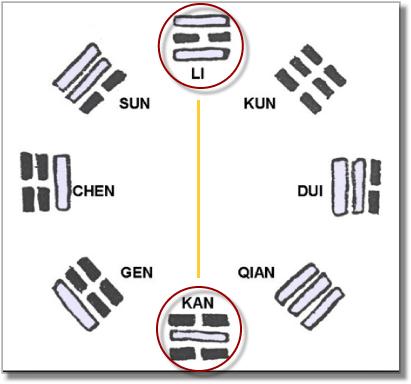
Later Heaven Bagua.
Later heaven is the bague of change, of living in the relative experience of change, sequence, linearity, seasonality, and tied to this is our experience of "confused sequence," of habitual patterns or the nidana experience (chain of causation) as described in Buddhism.

Wheel of Vertical Time.
The Wheel of Vertical Time combines the early and later heaven baguas in a way that we can visualize and apply as a meditation practice in any given time and place. It is a map for orienting or aligning ourselves to the innate dimensions of time and place, and the self-existing structures of past, present and future within our human body.
I Ching and the Human Body; themes of our Human Design Gates:
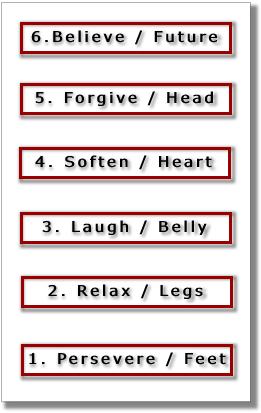
The "circuit breakers" in the illustration above help us to embrace our shadow and release our gift. They apply not only to the literal parts of our body (as illustrated) , but to the gates of our Human Design body graph. In other words, a key way for me to work with the quality of my Personality Sun, Gate 21.6, is to believe, the sixth-line circuit breaker. Belief or confidence in my authority (the gift theme) helps me embrace the feeling of needing to control [something], or of feeling controlled (shadow).
Personality Sun: Life's Work

The Gate and line of ones Personality Sun in the Human Design body graph (in my example, 21.6) represents ones "Life's Work," a kind of role one plays according the position of the line, i.e., one through six. You can use this "hexagram" of the positions to contemplate your own life's work, per the Discussion Page of Class Four.
Other Ways to Approach The Hexagram:
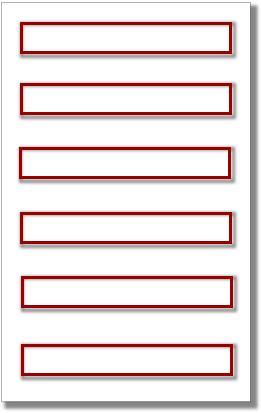
?
The six lines of the I Ching can by used as a tabula rasa for intuitively contemplating (or inviting the dralas to dialogue) aspects of ones life. For instance, write down the names of six of the most significant people in your life at this time. Then, without over-thinking it, assign the names to the six lines of the hexagram. Alternately, write each name down on a separate card, turn the cards over, shuffle them, and then draw a card from the top; assign it to the first line, the next card to the second line, and so on. Then contemplate the result. [See audio for more details.]
I Ching & The Human Body
An On-line Class with Bill Scheffel
Introduction & To Register
Class One: The Trigrams
Class Two: The Hexagram
Class Three: The Hexagram II
Class Four: Assimilation
Class Five: Early Heaven...
Class Six: Acquired Conditioning..
Class Seven: Standing Under...
See more classes...
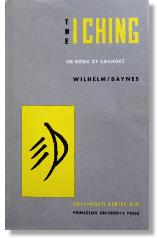
INTUITIVE DIALOGUES & I CHING READINGS with Bill Scheffel
The I Ching is a teacher to me, a revered guide, even a "hobby" - something I simply love to study, consult and share with others. I first opened the I Ching in 1970, when still in high school, intrigued and mystified by what it had to say. I began to actively engage with the I Ching in 1990, soon after I met Howard Bad Hand, an indispensable teacher who opened the book for me, removed the mystification and made it practical. in 2001, I began consulting the I Ching every morning, a practice that became a way of life.
I offer I Ching-intuitive readings for people in person, over the phone or through Skype. A reading begins with an initial conversation in which I listen to the issues in your life that form the basis of your question. From there, you "throw the coins" and I study the outcome in preparation for the full reading, typically done the following day. I help bring the symbolic images of the I Ching into the fabric of your question and life. Though the council I provide is founded on my experience with the I Ching, and intuitive guidance - the psychic or intangible dimension of life - it is very much a mutual conversation, a container we create together for insight to occur.
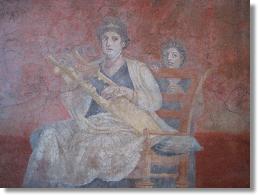
What is the I Ching?
The I Ching is perhaps humanity's oldest book, with roots preceding the Chinese Xia Dynasty of 2200 - 1800 BCE. The I Ching consists of sixty-four hexagrams, symbolic images that mirror the various life-situations we find ourselves in, and offer guidance for making correct decisions.
Traditionally called an oracle, the I Ching is a way of opening our life-questions to a larger system. Jung called this system synchronicity, “the peculiar interdependence” between ourselves and the events around us." This is also the world of the unconscious, of dreams, of contemplation. It is the world of spirit, the world of the dralas. This larger world is potentially always available to us, ready to support our highest aspirations.
The I Ching is way of consulting this larger world, and our own heart, the very center of the crossroads of life decisions. Our heart, as a spiritual force, is "outside of time" - i.e., beyond our usual occupations of hope and fear. In consulting the I Ching we "receive" a given hexagram through a random method - typically tossing coins. In such a method we have no control over the outcome, only the courage to inquire. In this matrix of sincerity and surrender, synchronicity can speak and spirit can enter, voices that can resonate with the truth of our own heart, the ultimate place of guidance.

I Ching, the "Book of Change" is considered the oldest of the Chinese classics, and has throughout its history commanded unsurpassed prestige and popularity. It has been considered a book of fundamental principles by philosophers, politicians, mystics, alchemists, yogins, diviners, sorcerers, and more recently, scientists and mathematicians... Continuing interest in the I Ching is enhanced by the fact that it has never been universally regarded as the sole property of any particular religion, cult or school of thought. - Introduction to The Taoist I Ching, translated by Thomas Cleary.
